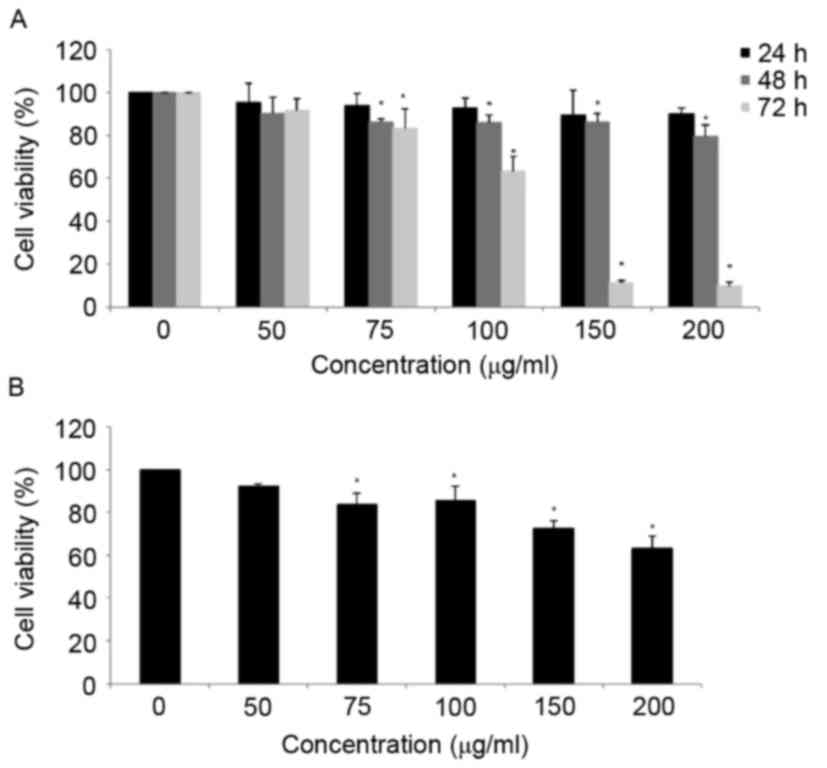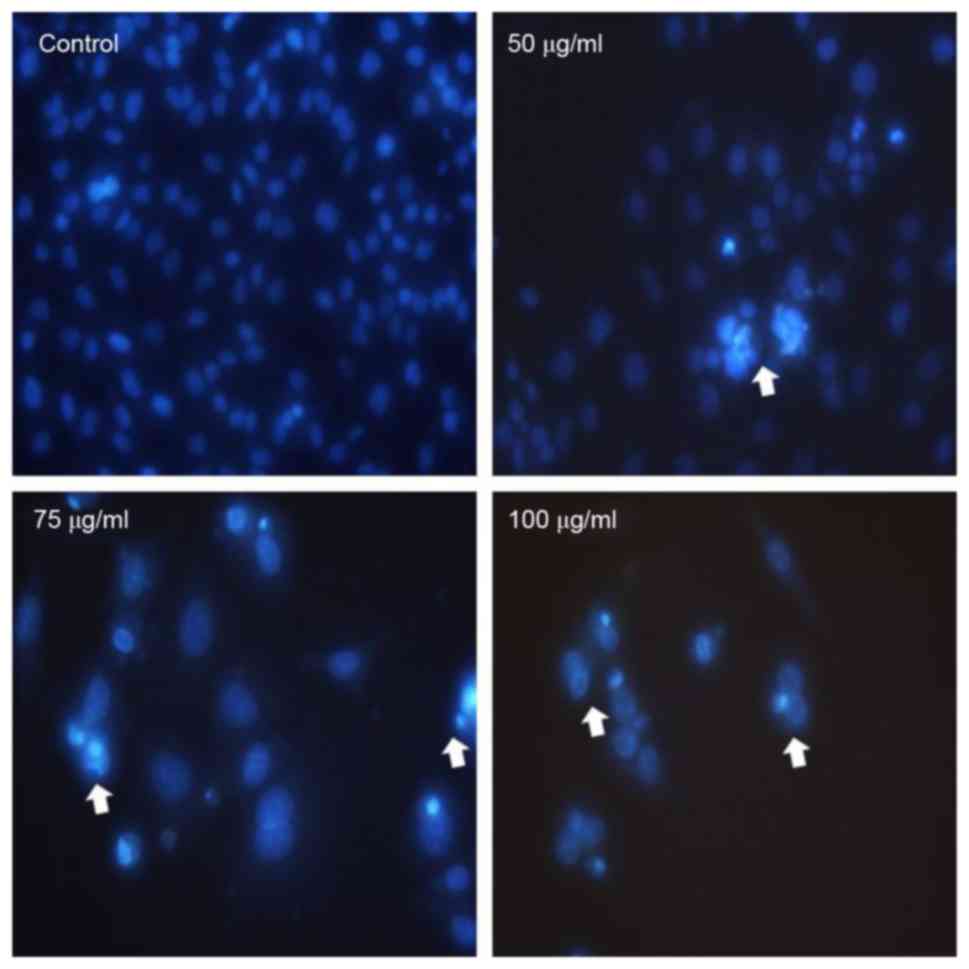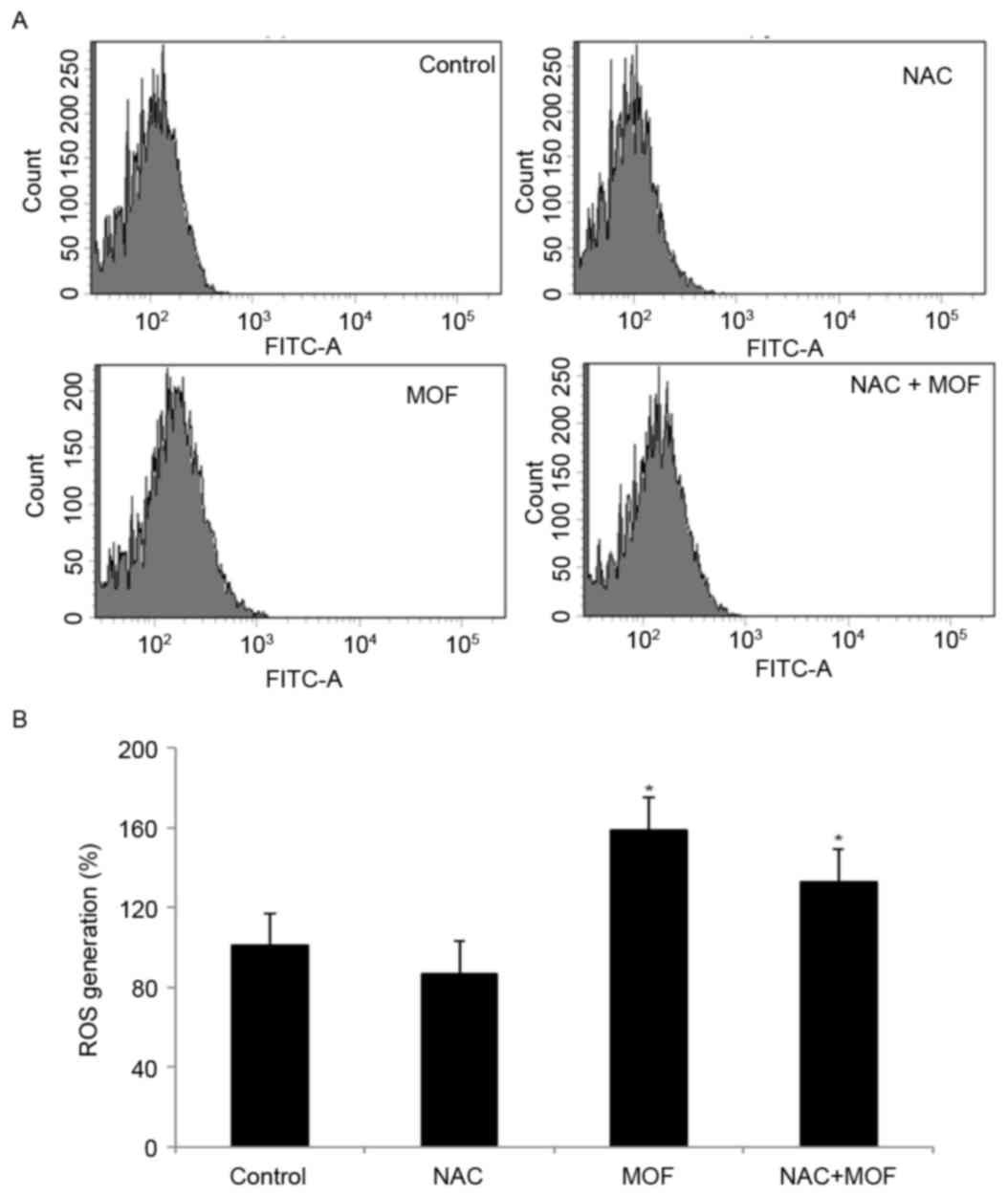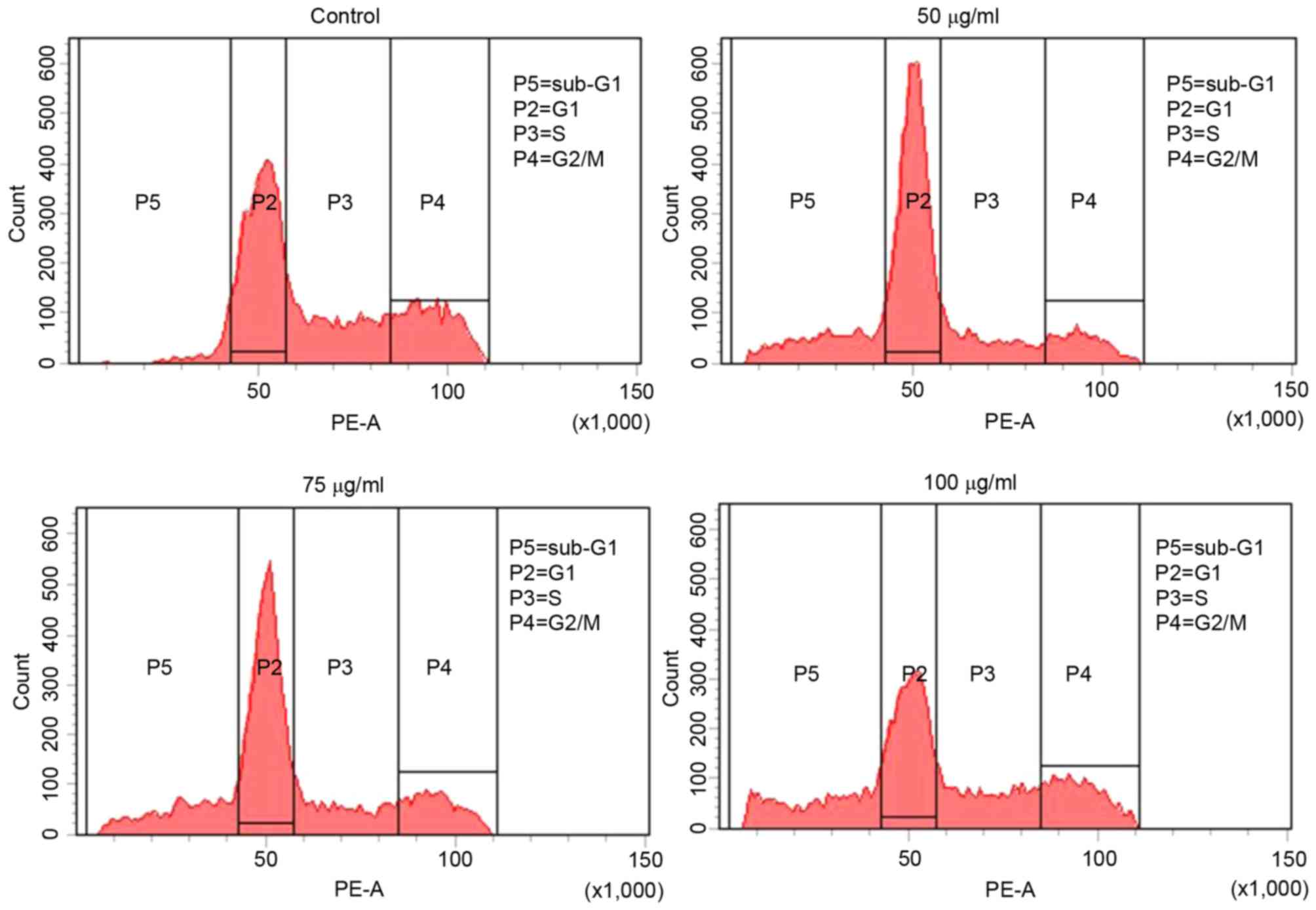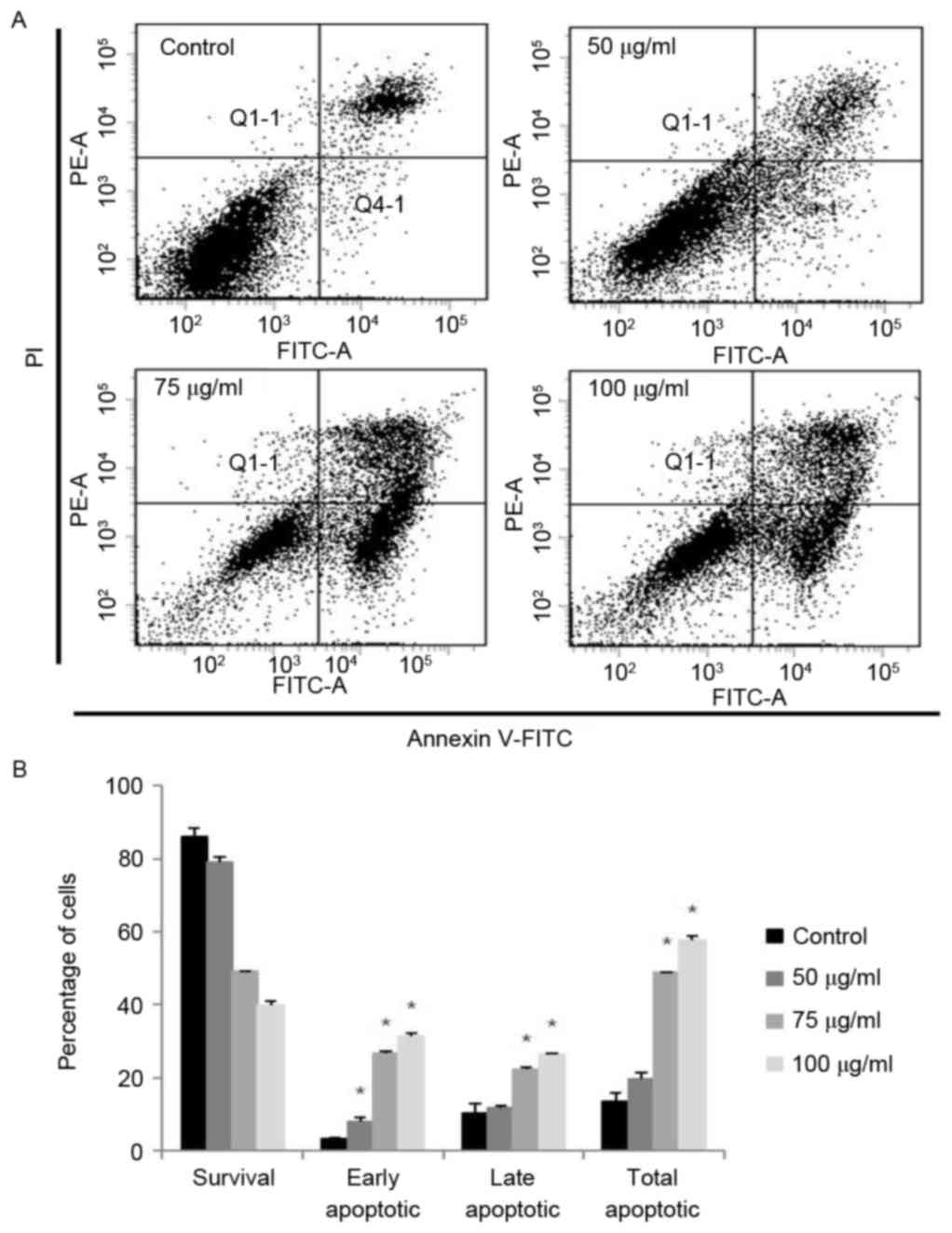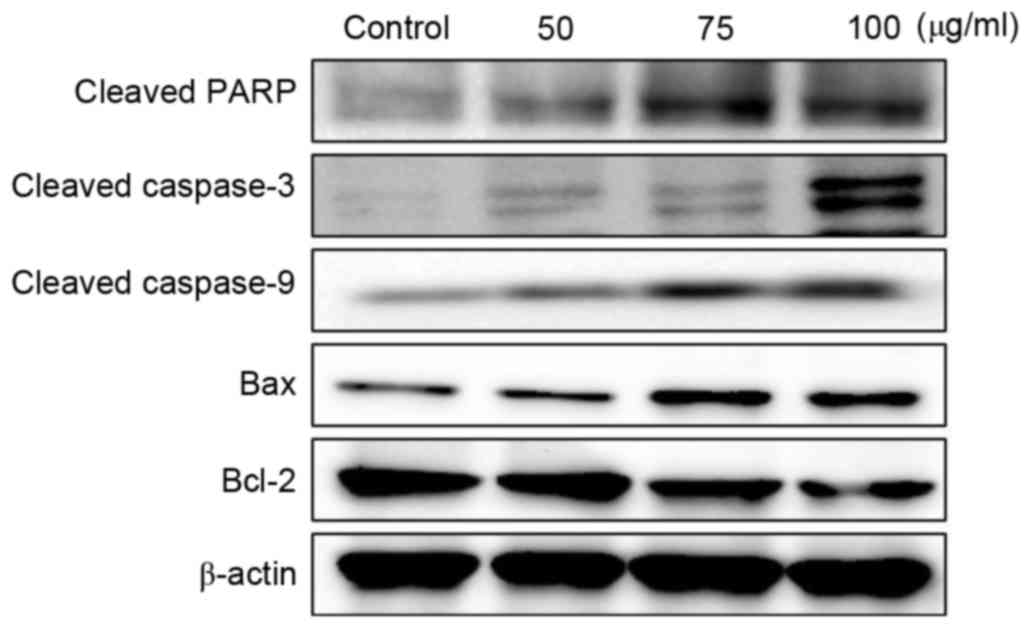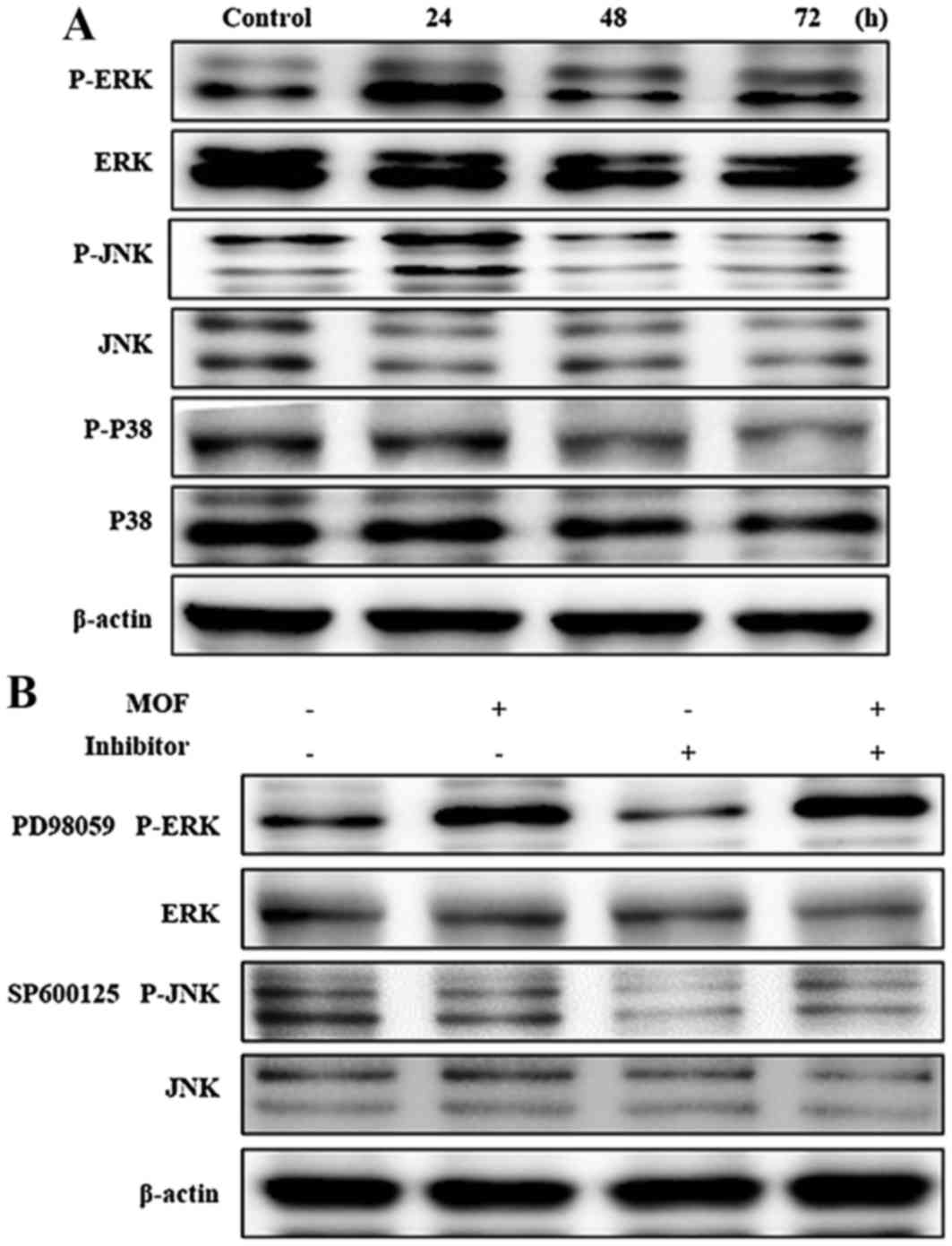Moringa oleifera fruit induce apoptosis via reactive oxygen species‑dependent activation of mitogen‑activated protein kinases in human melanoma A2058 cells
- Authors:
- Published online on: May 31, 2017 https://doi.org/10.3892/ol.2017.6288
- Pages: 1703-1710
Abstract
Introduction
Malignant melanoma is the most serious type of skin cancer and develops in melanocytes that produce melanin pigment (1). The most common site of malignant melanoma is the upper back, although it also occurs in the arms and legs (2). Previous studies have demonstrated that age, skin type and a family history of melanoma significantly affect the development of malignant melanoma. Surgery is the main treatment for early-stage malignant melanoma (3). However, there is no available treatment when melanoma passes early stage, or upon recurrence, making it an incurable disease with a high rate of metastasis (4,5). Moringa oleifera Lam is a tree of the Moringaceae family that can reach a height of between 5 and 10 m (6). Moringa is cultivated in Asia, Africa and Arabia, and is a good source of nutrition, since the plant is rich in proteins and vitamins (7). It has various pharmacological effects, including anti-hyperglycemic, anti-inflammatory and anticancer functions (8). Moringa leaves are the most nutritious part, as they are rich in β-carotene, proteins, vitamin C, calcium and antioxidants (9). There are two types of cell death process: Apoptosis and necrosis. Apoptosis is an important physiological mechanism in which apoptotic cells cause immune responses for removal of dead cells without destruction of surrounding cells, leading to characteristic cell changes, including cell shrinkage and membrane blebbing (10). This active process is mediated under the control of gene regulation (11). Reactive oxygen species (ROS) induce cancer and aging, formation of lipid peroxides, destruction of proteins and nucleic acids, and inhibition of various enzyme functions by attacking living cells. ROS are also mediators of intracellular signaling (12). However, excessive ROS production increases oxidative stress, resulting in cellular damage and inhibition of cellular functions and the cell cycle to cause apoptosis (13,14). Chemotherapeutic agents, including anticancer agents, exert relatively marked toxic effects, although certain cancer cells exhibit resistance. Once cancer cells acquire resistance to a particular anticancer agent, they have resistance to all anticancer agents operating via the same mechanism (15). Therefore, anticancer agents derived from natural compounds have been developed with decreased side effects and increased anticancer activity (16,17). It is important for patients to strengthen their immune systems upon occurrence of malignant melanoma. As synthetic anticancer agents may weaken the immune system, more studies on natural products for treatment of malignant melanoma are required. For the identification of cytoprotective agents from natural resources, the present study investigated the cytoprotective mechanisms underlying Moringa oleifera fruit, against mitochondrial apoptosis with respect to the induction of ROS formation, and c-Jun N-terminal kinase (JNK) and extracellular-signal-regulated kinase (ERK) activation in human melanoma A2058 cells.
Materials and methods
Plants and sample extraction
Moringa oleifera fruit (MOF) were collected at Dar es Saalam, Tanzania, in September 2013. Botanical identification was made by Professor Henry Joseph Hjndangalasi, Department of Botany, Dar es Salaam University, Dar es Salaam, Tanzania. Dried MOF (13.0 g) were soaked in 70% ethanol and sonicated (40 kHz) for 3 h at room temperature. Extracts were evaporated in a dry oven at 60°C and stored at −20°C until used for the in vitro assay (yield, 0.2794 g).
Chemicals and reagents
MTT and propidium iodide were purchased from Sigma-Aldrich (Merck KGaA, Darmstadt, Germany). Primary mouse monoclonal antibodies against β-actin (catalog no. sc-47778; dilution, 1:1,000) and rabbit monoclonal antibodies against B-cell lymphoma-2 (Bcl-2; catalog no. sc-492; dilution, 1:1,000) and Bcl-2-associated X protein (Bax; catalog no. sc-493; dilution, 1:1,000) were purchased from Santa Cruz Biotechnology, Inc. (Dallas, TX, USA). Rabbit monoclonal antibodies against cleaved caspases-3 (dilution, 1:1,000; catalog no. 9661), −8 (dilution, 1:1,000; catalog no. 8592) and −9 (dilution, 1:1,000; catalog no. 7237) and poly (ADP-ribose) polymerase (PARP; dilution, 1:1,000; catalog no. 5625) were purchased from Cell Signaling Technology, Inc. (Danvers, MA, USA). Horseradish peroxidase (HRP)-conjugated goat anti-rabbit IgG (HRP; catalog no. sc-2004; dilution, 1:2,000) and HRP-conjugated goat anti-mouse IgG (catalog no. sc-2005; dilution, 1:2,000) secondary antibodies were purchased from Santa Cruz Biotechnology, Inc. Primary antibodies against caspase-9 (catalog no. 9501; dilution, 1:1,000), caspase-3 (catalog no. 9664; dilution, 1:1,000), JNK (catalog no. 9258; dilution, 1:1,000), phosphorylated (p)-JNK (catalog no. 4668; dilution, 1:1,000), ERK (catalog no. 4695; dilution, 1:1,000), p-ERK (catalog no. 4370; dilution, 1:1,000), p38 (catalog no. 9212; dilution, 1:1,000) and p-p38 (catalog no. 4511; dilution, 1:1,000) antibodies were purchased from Cell Signaling Technology, Inc. All other chemicals and reagents were of the highest analytical grade.
Cell culture
The human melanoma A2058 and human keratinocyte HaCaT cell lines were purchased from the Korean Cell Line Bank (Seoul, Korea) and Amore Pacific (Yongin, Gyeonggi-do, Republic of Korea). respectively. Cells were maintained at 37°C in Dulbecco's modified Eagle's medium (DMEM; Gibco, Thermo Fisher Scientific, Inc., Waltham, MA, USA), supplemented with 10% fetal bovine serum (Invitrogen; Thermo Fisher Scientific, Inc.), 100 U/ml penicillin and 100 µg/ml streptomycin (Gibco; Thermo Fisher Scientific, Inc.). Cells were incubated at 37°C in an incubator with a humidified atmosphere containing 5% CO2 and were subcultured every 2 to 3 days. Cell counts were performed using a hemocytometer from Hausser Scientific (Horsham, PA, USA).
Cell viability assay
The cytotoxic effects of MOF extract on the A2058 and HaCaT cell lines were estimated colorimetrically using the MTT method, which is based on the reduction of tetrazolium salt by mitochondrial dehydrogenase in viable cells (18). The cells were seeded on a 96-well plate (density, 2×106 cells/ml) and were then treated with MOF extract at final concentrations of 0, 50, 75 and 100 µg/ml. After 72 h of incubation at 37°C, 50 µl MTT solution (2 mg/ml) was added to each well at a final concentration of 0.4 mg/ml. After 2 h of incubation at 37°C, the supernatants were aspirated and replaced with 150 µl dimethyl sulfoxide to dissolve the formazan product. The absorbance at 540 nm was then read using a spectrophotometric plate reader (model 550; Bio-Rad Laboratories, Inc., Hercules, CA, USA). The results were calculated as percentages relative to the unexposed control.
Nuclear staining with Hoechst 33258
The nuclear morphology of the cells was observed using the DNA-specific blue fluorescent dye Hoechst 33258. The viable cells were stained homogeneously, whereas the apoptotic cells that exhibited chromatin condensation or nuclear fragmentation were not stained (19). The A2058 cells were treated with MOF extract at the various concentrations (0, 50, 75, 100 µg/ml). Cells were then fixed for 30 min at 37°C in 100% methanol, washed with PBS and stained with 2 µg/ml Hoechst 33258 (Sigma-Aldrich; Merck KGaA). The cells were observed under a BX51 fluorescence microscope (magnification, ×200) and images were captured with a DP70 camera (Olympus Corporation, Tokyo, Japan).
Determination of ROS levels
Intracellular ROS generation was assessed using the stable nonpolar dye 2′,7′-dichlorodihydrofluorescein diacetate (H2DCF-DA; Sigma-Aldrich; Merck KGaA), which readily diffuses into the cells (20). Following treatment with MOF extract (100 µg/ml) for 24 h at 37°C, the A2058 cells were incubated at 37°C with 25 µM H2DCF-DA for 30 min, and then washed twice with ice-cold PBS. The ROS production was measured using a FACSCalibur flow cytometer (BD Biosciences, San Jose, CA, USA). To cells grown in 6-well plates (1×106 cells/ml) for 24 h, an antioxidant N-acetyl-L-cystein (NAC; 2 mM) was added for 1 h prior to exposing them to 100 µg/ml MOF extract for 72 h at 37°C. A total of 25 µM of H2DCF-DA was then added and the cells incubated for 30 min at 37°C, and then washed twice with ice-cold PBS. The ROS production was evaluated using a FACSCalibur flow cytometer (BD Biosciences).
Cell cycle analysis
Cell cycle analysis was performed to determine the proportion of apoptotic sub-G1 hypodiploid cells (21). The A2058 cells were plated on 6-well plates (1×106 cells/ml) and incubated for 24 h at 37°C. The cells were treated with MOF extract (0, 50, 75, 100 µg/ml) and incubated for 72 h at 37°C, following which they were trypsinized, harvested and washed with PBS. The pellet was fixed using ice-cold 70% ethanol at 4°C for 30 min. The cells were then washed once with PBS and resuspended in 50 µg/ml ice-cold propidium iodide (PI) containing 50 µg/ml RNase A in PBS (pH 7.4) for 30 min in the dark. Fluorescence emitted from the PI-DNA complex was quantified using a FACSCalibur flow cytometer.
Apoptosis analysis
An Annexin V-PI double staining assay was performed to differentiate early and late apoptosis stages. The assay was determined using an ApoScan™ Annexin V-fluorescein isothiocyanate (FITC) apoptosis detection kit (BioBud Co. Ltd., Seoul, Korea) in the MOF extract-treated A2058 cells. Cells were trypsinized, harvested and washed with PBS, and were subsequently were resuspended in 500 µl 1X binding buffer (50 mM HEPES, 700 mM NaCl, 12.5 mM CaCl2, PH 7.4) and incubated with 1.25 µl Annexin V-FITC (200 µg/ml) at room temperature for 15 min. The supernatant was then removed following centrifugation at 400 × g for 10 min at 4°C. The cells were then resuspended in 500 µl 1X binding buffer, and cell suspensions were stained with 10 µl PI (30 µg/ml) at 4°C in the dark. Fluorescence was quantified using a FACSCalibur flow cytometer. The number of cells in early and late apoptosis was determined as the percentage of Annexin V+/PI− or Annexin V+/PI+ cells, respectively.
Western blot analysis
Western blot analyses were performed as previously described (22). The cells were cultured, harvested and lysed on ice for 30 min in lysis buffer (120 mM NaCl, 40 mM, pH 8.0, and 0.1% nonyl phenoxypolyethoxylethanol) and were then centrifuged at 13,000 × g for 15 min at 4°C. Lysates from each sample were mixed with 5X sample buffer (0.375 M Tris-HCl, 5% SDS, 5% 2-mercaptoethanol, 50% glycerol and 0.05% bromophenol blue, pH 6.8) and were then heated to 95°C for 5 min. Equal amounts of protein (25 µg) were separated by SDS-PAGE (12% gel) and were transferred onto nitrocellulose membranes. The membranes were then washed with TBS (10 mM Tris-HCl and 150 mM NaCl) containing 0.05% Tween-20 (TBST), and were then blocked in TBST containing 5% nonfat dried milk. The membranes were then incubated with the aforementioned specific primary antibodies overnight at 4°C. Subsequent to 3 washes in TBST, the membranes were incubated with the appropriate HRP-conjugated secondary antibodies for 1 h at room temperature. The membranes were then washed 3 times in TBST with 15 min between each step, and protein detection was performed using an enhanced chemiluminescence western blotting detection ECL kit (Bio-Rad, Hercules, CA, USA). The intensity of each band was analyzed using Image J software (version k 1.45; National Institute of Health, Bethesda, MD, USA). The expression level of individual proteins in the MOF-treated cells was evaluated and expressed relative to that of the control, of which the expression level was designated as 1.0.
Statistical analysis
SPSS software (version 22.0; IBM SPSS, Armonk, NY, USA) was used to analyze the data. The results were subjected to analysis of variance, followed by Tukey's range test in order to analyze the differences between conditions. In each case, P<0.05 was considered to indicate a statistically significant difference. All measurements were made in triplicate, and all values are presented as the mean ± standard deviation.
Results
Cytotoxic effects of MOF extract in A2058 and HaCaT cell lines
To examine the proliferation inhibitory effects of MOF extract, human melanoma A2058 cells were exposed to MOF extract at concentrations of 50, 75 and 100 µg/ml for 72 h, prior to the cell viability being determined using an MTT assay. As presented in Fig. 1A, MOF extract decreased the viability of A2058 cells in a dose-dependent manner. The viability of MOF extract-treated A2058 cells was decreased to 91.6, 83.1 and 63.5% at concentrations of 50, 75 and 100 µg/ml for 72 h, respectively. At concentrations of 150 and 200 µg/ml, the MOF extract markedly decreased the cell proliferation to 11.3 and 10.1%, respectively. To compare the cytotoxic effects of MOF extract in human keratinocyte HaCaT cells, the HaCaT cells were treated with concentrations of MOF extract of 50, 75, 100, 150 and 200 µg/ml for 72 h. The results indicated that HaCaT cells were more resistant to MOF extract-induced cytotoxicity compared with human melanoma A2058 cells (Fig. 1B). Therefore, MOF extract concentrations of 50, 75 and 100 µg/ml were selected for subsequent experiments.
Induction of apoptosis in A2058 cells
The apoptogenic property of MOF extract was investigated through morphological changes in A2058 cells. Nuclear Hoechst 33258 staining was performed in order to determine whether the anti-proliferative effect of MOF extract was due to apoptosis. As presented in Fig. 2, A2058 cells treated with MOF extract exhibited a number of morphological changes, including membrane blebbing, nuclear fragmentation, chromatin condensation and an increased density of apoptotic bodies compared with the untreated control cells. The number of apoptotic cells increased in a dose-dependent manner, which is consistent with the results of the MTT assay.
Effects on generation of ROS
To investigate the possible underlying mechanisms of MOF extract-induced apoptosis, ROS production was examined using the specific fluorescent probe H2DCF-DA. Using flow cytometry, MOF extract caused a rightward shift for H2DCF-DA, indicating increased production of hydroxyl radicals and hydrogen peroxide, compared with the control, followed by cell death (Fig. 3A). However, co-treatment with MOF extract and NAC slightly attenuated ROS production, compared with MOF extract alone, indicating that NAC may act as a scavenger of ROS (Fig. 3B). The results demonstrated that ROS is involved in MOF extract-mediated apoptotic processes.
Effects on cell cycle progression in A2058 cells
To investigate the effect of MOF extract on cell cycle progression, flow cytometry was performed with 50, 75 and 100 µg/ml MOF extract. As presented in Fig. 4, 13.9% of control cells were in sub-G1 phase, whereas 29.9, 31.1 and 57.5% of MOF extract-treated cells were in sub-G1 phase, at concentrations of 50, 75 and 100 µg/ml, respectively. This was accompanied by a significant decrease in the numbers of A2058 cells in S phase of 28.5, 20.5 and 16.3%, and G2/M phase of 23.1, 18.7 and 6.9 at 50, 75 and 100 µg/ml, respectively.
Effects on apoptosis in A2058 cells
In order to quantify the percentage of apoptotic cells, flow cytometry analysis was performed using double staining with Annexin V and PI. The Annexin V−/PI− population was considered to account for unaffected cells, the Annexin V+/PI− population represented early apoptosis, the Annexin V+/PI+ population represented late apoptosis and the Annexin V−/PI+ population represented necrosis. The results demonstrated that the treatment of the cells with MOF extract significantly increased the percentage of apoptotic cells compared with untreated control cells (Fig. 5). MOF extract-treated A2058 cells exhibited increased proportions of early apoptotic cells to 6.5, 27.3 and 31.9% at 50, 75 and 100 µg/ml, respectively, compared with 3.2% for the control. The proportions of late apoptotic cells also increased to 11.2, 21.6 and 26.6% at 50, 75 and 100 µg/ml, respectively, compared with 9.0% for the control. The total number of apoptotic cells increased from 12.2% in control cells to 17.7, 48.9 and 58.5% at 50, 75 and 100 µg/ml, respectively. The proportion of early apoptotic cells was increased at 50 µg/ml compared with that of late apoptotic cells. However, the population of late apoptotic cells was increased compared with that of early apoptotic cells. From these results, it is hypothesized that anti-proliferative effects of MOF extract in A2058 melanoma cells may be mediated by the induction of cell apoptosis in a dose-dependent manner.
Effects on Bcl-2, Bax and caspase expression in A2058 cells
In order to investigate the effects of MOF extract on apoptosis in A2058 cells, the expression levels of apoptotic regulatory proteins, including Bcl-2, Bax and caspases, were examined. As presented in Fig. 6, MOF extract increased Bax protein expression, but decreased the expression of Bcl-2, in a dose-dependent manner. The disruption of the mitochondrial plasma membrane by MOF extract was followed by the activation of the cleaved caspase-3 and 9 and target protein, PARP, respectively. These results, together with the Bax/Bcl-2 ratio, indicated that the MOF extract may induce apoptosis through the regulation of apoptosis-associated protein expression in human melanoma A2058 cells.
Effects on mitogen-activated protein kinase (MAPK) expression in A2058 cells
The MAPKs, including JNK, ERK and p38 kinase, are present in all eukaryotes and have been demonstrated to perform central roles in regulating cell proliferation, differentiation and apoptosis (23). In order to investigate the effects of MOF extract in A2058 cells, the phosphorylation of MAPKs was determined. As presented in Fig. 7A, expression levels of non-phosphorylated ERK, JNK and p38 were unchanged with MOF extract. By contrast, accumulation of p-ERK and p-JNK markedly increased in a time-dependent manner. These results indicated that MOF extract induces apoptosis through activation of ERK and JNK in A2058 cells. In order to determine the effects of ERK and JNK on MOF extract-induced A2058 cytotoxicity, the kinase-specific inhibitors SP600125 and PD98058 were used. As presented in Fig. 7B, co-treatment with MOF extract and inhibitors blocked MOF extract-mediated p-ERK and p-JNK accumulation. The cumulative results indicated that ERK and JNK are involved in the regulation of MOF extract-induced mitochondrial apoptosis in A2058 cells.
Discussion
The incidence rate of malignant melanoma has continued to increase by between 3 and 7% each year in Western countries (24). In addition, as the climate changes, exposure to harmful ultraviolet (UV) rays has become a concern due to increasing incidence of various types of skin cancer (25). As malignant melanoma exhibits resistance to chemotherapy or immunotherapy, complete treatment has become problematic (26,27).
Seeds, roots, leaves, flowers and bark of Moringa oleifera have been used as materials for cosmetics and medicine (28). As the anti-inflammatory, anticancer and antioxidant effects of MOF extract have been validated (29,30), the present study investigated the effects of MOF extract on apoptosis and ROS accumulation in malignant melanoma cells.
ROS are generated by active processes in normal cells and are associated with various biological processes, including cell differentiation and gene expression (31). Therefore, ROS homeostasis is important for cell viability and survival. Although the association between ROS and apoptosis has been reported to be contradictory, ROS perform a role as an intermediate mediator that delivers signals for apoptosis (32).
MAPKs are protein kinases activated by a variety of stimuli, and regulate cell proliferation, differentiation, proliferation and death (33,34). MAPKs consist of JNK, p38 and ERK proteins (35). In general, ERK is activated by growth factors, cytokines and phorbol ester and is involved in cell proliferation or differentiation (36). By contrast, JNK and p38 are activated by proinflammatory cytokines, UV irradiation, heat, osmotic shock, hydrogen peroxide and DNA damage induced by stress and is involved in proliferation inhibition and apoptosis (37–40). However, previous studies have reported that ERK, JNK and p38 are involved in cell survival and death (41,42). The present study revealed that JNK and ERK are involved in the apoptotic effects of MOF extract.
Apoptosis, also termed programmed cell death, is required to control the number of normal cells and is induced by various types of damage (43). In addition, apoptosis serves as an important control mechanism of homeostasis, as it is involved in the removal of harmful cells, and is induced by internal and external signaling (44). Upon apoptosis, cells are morphologically characterized by membrane detachment, membrane blebbing, nuclear condensation, exposure of phosphatidylserine to the extracellular space and DNA fragmentation (45). Apoptosis may be initiated by one of two pathways: The intrinsic or the extrinsic pathway (46). In the intrinsic pathway, loss of mitochondrial transmembrane potential results in the release of cytochrome c into the cytosol, formation of apoptotic protease-activating factor 1 (Apaf-1) and activation of caspase-9. Caspase-9 then activates downstream caspases-3, −6 and −7 (47,48). In the extrinsic pathway, Fas-associated death domain protein and caspase-8 are activated through Fas and tumor necrosis factor receptors, which are death receptors (49). Bax and Bak proteins are widely known for their cell killing activity (50). Alterations in the expression of Bcl-2 family proteins inhibit dimerization of Bcl-2 family members on the outer mitochondrial membrane, which induces release of mitochondrial proteins, including cytochrome c, Apaf-1, second mitochondria-derived activator of caspase/direct inhibitor of apoptosis-binding protein with low pI and apoptosis-inducing factor, and promotes apoptosis (51,52). Caspase-3 is generally inactive (pro-caspase-3) in cells and activated by death signaling, which catalyzes proteolytic cleavage of PARP as an apoptosis-specific marker (53,54). In the present study, the Bax/Bcl-2 ratio was identified to have increased and PARP was cleaved by caspase-3 via the caspase-9 signaling pathway.
The results of the present study revealed the apoptotic effects of MOF extract via ROS production in melanoma cells. Therefore, MOF extract inhibits the proliferation of human melanoma A2058 cells by generating ROS, which regulate expression of proteins involved in survival and apoptosis of cancer cells.
Acknowledgements
The present study was supported by the International Research and Development Program of the National Research Foundation, by the Ministry of Education, Science and Technology, Republic of Korea (grant no. NRF-2014K1A3A1A09063352).
References
|
Singh S, Zafar A, Khan S and Naseem I: Towards therapeutic advances in melanoma management: An overview. Life Sci. Feb 23–2017.(Epub ahead of print). View Article : Google Scholar | |
|
Shayanfar N, Bahari L, Safaie-Naraghi Z, Kamyab K, Gheytanchi E and Rezaei N: Negative HER2/neu amplification using immunohistochemistry and chromogenic in situ hybridization techniques in skin melanoma cases. Asian Pac J Cancer Prev. 16:421–425. 2015. View Article : Google Scholar : PubMed/NCBI | |
|
Read RL, Pasquali S, Haydu L, Thompson JF, Stretch JR, Saw RP, Quinn MJ, Shannon K and Spillane AJ: Quality assurance in melanoma surgery: The evolving experience at a large tertiary referral centre. Eur J Surg Oncol. 41:830–836. 2015. View Article : Google Scholar : PubMed/NCBI | |
|
Markovic SN, Erickson LA, Rao RD, Weenig RH, Pockaj BA, Bardia A, Vachon CM, Schild SE, McWilliams RR, Hand JL, et al: Melanoma melanoma in the 21st century, part 2: Staging, prognosis, and treatment. Mayo Clin Proc. 82:pp. 490–513. 2007; View Article : Google Scholar : PubMed/NCBI | |
|
Siegel R, Naishadham D and Jemal A: Cancer statistics for Hispanics/Latinos. CA Cancer J Clin. 62:283–298. 2012. View Article : Google Scholar : PubMed/NCBI | |
|
Anwar F, Latif S, Ashraf M and Gilani AH: Moringa oleifera A food plant with multiple medicinal uses. Phytother Res. 21:17–25. 2007. View Article : Google Scholar : PubMed/NCBI | |
|
Leone A, Fiorillo G, Criscuoli F, Ravasenghi S, Santagostini L, Fico G, Spadafranca A, Battezzati A, Schiraldi A, Pozzi F, et al: Nutritional characterization and phenolic profiling of Moringa oleifera leaves grown in chad, sahrawi refugee camps, and haiti. Int J Mol Sci. 16:18923–18937. 2015. View Article : Google Scholar : PubMed/NCBI | |
|
Bharali R, Tabassum J and Azad MR: Chemomodulatory effect of Moringa oleifera, Lam, on hepatic carcinogen metabolising enzymes, antioxidant parameters and skin papillomagenesis in mice. Asian Pac J Cancer Prev. 4:131–139. 2003.PubMed/NCBI | |
|
Siddhuraju P and Becker K: Antioxidant properties of various solvent extracts of total phenolic constituents from three different agroclimatic origins of drumstick tree (Moringa oleifera Lam.) leaves. J Agric Food Chem. 51:2144–2155. 2003. View Article : Google Scholar : PubMed/NCBI | |
|
Kim DH, Park KW, Chae IG, Kundu J, Kim EH, Kundu JK and Chun KS: Carnosic acid inhibits STAT3 signaling and induces apoptosis through generation of ROS in human colon cancer HCT116 cells. Mol Carcinog. 55:1096–1110. 2016. View Article : Google Scholar : PubMed/NCBI | |
|
Clarke PG and Clarke S: Historic apoptosis. Nature. 378:2301995. View Article : Google Scholar : PubMed/NCBI | |
|
Stadtman ER: Protein oxidation in aging and age-related diseases. Ann N Y Acad Sci. 928:22–38. 2001. View Article : Google Scholar : PubMed/NCBI | |
|
Sauer H, Wartenberg M and Hescheler J: Reactive oxygen species as intracellular messengers during cell growth and differentiation. Cell Physiol Biochem. 11:173–186. 2001. View Article : Google Scholar : PubMed/NCBI | |
|
Kuo PL, Chen CY and Hsu YL: Isoobtusilactone A induces cell cycle arrest and apoptosis through reactive oxygen species/apoptosis signal-regulating kinase 1 signaling pathway in human breast cancer cells. Cancer Res. 67:7406–7420. 2007. View Article : Google Scholar : PubMed/NCBI | |
|
Burris HA III: Overcoming acquired resistance to anticancer therapy: Focus on the PI3K/AKT/mTOR pathway. Cancer Chemother Pharmacol. 71:829–842. 2013. View Article : Google Scholar : PubMed/NCBI | |
|
Alcazar O, Achberger S, Aldrich W, Hu Z, Negrotto S, Saunthararajah Y and Triozzi P: Epigenetic regulation by decitabine of melanoma differentiation in vitro and in vivo. Int J Cancer. 131:18–29. 2012. View Article : Google Scholar : PubMed/NCBI | |
|
Triozzi PL, Aldrich W, Achberger S, Ponnazhagan S, Alcazar O and Saunthararajah Y: Differential effects of low-dose decitabine on immune effector and suppressor responses in melanoma-bearing mice. Cancer Immunol Immunother. 61:1441–1450. 2012. View Article : Google Scholar : PubMed/NCBI | |
|
Carmichael J, DeGraff WG, Gazder AF, Minnan JD and Mitchell JB: Evaluation of a tetrazolium-based semiautomated colorimetric assay: Assessment of chemosensitivity testing. Cancer Res. 47:936–942. 1987.PubMed/NCBI | |
|
Lizard G, Fournel S, Genestier L, Dgedin N, Chaput C, Flacher M, Mutin M, Panaye G and Revillard JP: Kinetics of plasma membrane and mitochondrial alterations in cells undergoing apoptosis. Cytometry. 21:275–283. 1995. View Article : Google Scholar : PubMed/NCBI | |
|
Cathcart R, Schwiers E and Ames BN: Detection of picomole levels of hydroperoxides using a fluorescent dichlorofluorescein assay. Anal Biochem. 134:111–116. 1983. View Article : Google Scholar : PubMed/NCBI | |
|
Nicoletti I, Migliorati G, Pagliacci MC, Grignani F and Riccardi C: A rapid and simple method for measuring thymocyte apoptosis by propidium iodide staining and flow cytometry. J Immunol Methods. 139:271–279. 1991. View Article : Google Scholar : PubMed/NCBI | |
|
Ryu MJ and Chung HS: [10]-Gingerol induces mitochondrial apoptosis through activation of MAPK pathway in HCT116 human colon cancer cells. In Vitro Cell Dev Biol Anim. 51:92–101. 2015. View Article : Google Scholar : PubMed/NCBI | |
|
Stadheim TA and Kucera GI: c-Jun N-terminal kinase/stress-activated protein kinase (JNK/SAPK) is required for mitoxantrone- and anisomycin-induced apoptosis in HL-60 cells. Leuk Res. 26:55–65. 2002. View Article : Google Scholar : PubMed/NCBI | |
|
Erdei E and Torres SM: A new understanding in the epidemiology of melanoma. Expert Rev Anticancer Ther. 10:1811–1823. 2010. View Article : Google Scholar : PubMed/NCBI | |
|
Diffey B: Climate change, ozone depletion and the impact on ultraviolet exposure of human skin. Phys Med Biol. 49:R1–R11. 2004. View Article : Google Scholar : PubMed/NCBI | |
|
Jerant AF, Johnson JT, Sheridan CD and Caffrey TJ: Early detection and treatment of skin cancer. Am Fam Physician. 62:357–368. 2000.PubMed/NCBI | |
|
Lopez RF, Lange N, Guy R and Bentley MV: Photodynamic therapy of skin cancer: Controlled drug delivery of 5-ALA and its esters. Adv Drug Deliv Rev. 56:77–94. 2004. View Article : Google Scholar : PubMed/NCBI | |
|
Rebecca HSU, Sharon M, Arbainsyah A and de Witte L: Moringa oleifera: Medicinal and Socio-Economic UsesInternational Course on Economic Botany. National Herbarium Leiden; The Netherlands: pp. 2–6. 2006 | |
|
Guevara AP, Vargas C, Sakurai H, Fujiwara Y, Hashimoto K, Maoka T, Kozuka M, Ito Y, Tokuda H and Nishino H: An antitumor promoter from Moringa oleifera Lam. Mutat Res. 440:181–188. 1999. View Article : Google Scholar : PubMed/NCBI | |
|
Mahajan SG and Mehta AA: Effect of Moringa oleifera Lam. seed extract on ovalbumin-induced airway inflammation in guinea pigs. Inhal Toxicol. 20:897–909. 2008. View Article : Google Scholar : PubMed/NCBI | |
|
Rhee SG: Cell signaling. H2O2, a necessary evil for cell signaling. Science. 312:1882–1883. 2006. View Article : Google Scholar : PubMed/NCBI | |
|
Ozben T: Oxidative stress and apoptosis: Impact on cancer therapy. J Pharm Sci. 96:2181–2196. 2007. View Article : Google Scholar : PubMed/NCBI | |
|
McCubrey JA, Lahair MM and Franklin RA: Reactive oxygen species-induced activation of the MAP kinase signaling pathways. Antioxid. Redox Signal. 8:1775–1789. 2006. View Article : Google Scholar | |
|
Dhillon AS, Hagan S, Rath O and Kolch W: MAP kinase signalling pathways in cancer. Oncogene. 26:3279–3290. 2007. View Article : Google Scholar : PubMed/NCBI | |
|
Hanawa N, Shinohara M, Saberi B, Gaarde WA, Han D and Kaplowitz N: Role of JNK translocation to mitochondria leading to inhibition of mitochondria bioenergetics in acetaminophen-induced liver injury. J Biol Chem. 283:13565–13577. 2008. View Article : Google Scholar : PubMed/NCBI | |
|
Roberts PJ and Der CJ: Targeting the Raf-MEK-ERK mitogen-activated protein kinase cascade for the treatment of cancer. Oncogene. 26:3291–3310. 2007. View Article : Google Scholar : PubMed/NCBI | |
|
Dérijard B, Hibi M, Wu IH, Barrett T, Su B, Deng T, Karin M and Davis RJ: JNK1: A protein kinase stimulated by UV light and Ha-Ras that binds and phosphorylates the c-Jun activation domain. Cell. 76:10251994. View Article : Google Scholar : PubMed/NCBI | |
|
Kyriakis JM, Banerjee P, Nikolakaki E, Dai T, Rubie EA, Ahmad MF, Avruch J and Woodgett JR: The stress-activated protein kinase subfamily of c-Jun kinases. Nature. 369:156–160. 1994. View Article : Google Scholar : PubMed/NCBI | |
|
Raingeaud J, Gupta S, Rogers J, Dickens M, Han J, Ulevitch R and Davis RJ: Pro-inflammatory cytokines and environmental stress cause p38 mitogen-activated protein kinase activation by dual phosphorylation on tyrosine and threonine. J Biol Chem. 270:7420–7426. 1995. View Article : Google Scholar : PubMed/NCBI | |
|
Davis RJ: Signal transduction by the JNK group of MAP kinases. Cell. 103:239–252. 2000. View Article : Google Scholar : PubMed/NCBI | |
|
Ichijo H: From receptors to stress-activated MAP kinases. Oncogene. 18:6087–6093. 1999. View Article : Google Scholar : PubMed/NCBI | |
|
Xia Z, Dickens M, Raingeaud J, Davis RJ and Greenberg ME: Opposing effects of ERK and JNK-p38 MAP kinases on apoptosis. Science. 270:1326–1331. 1995. View Article : Google Scholar : PubMed/NCBI | |
|
Strasser A, O'Connor L and Dixit VM: Apoptosis signaling. Ann Rev Biochem. 69:217–245. 2000. View Article : Google Scholar : PubMed/NCBI | |
|
Pathak S, Sharma CH, Jayaram HN and Singh N: Apoptotic signaling induced by benzamideriboside: An in vitro study. Mol Cell Biochem. 328:67–73. 2009. View Article : Google Scholar : PubMed/NCBI | |
|
Gschwind M and Huber G: Apoptotic cell death induced by beta-amyloid 1–42 peptide is cell type dependent. J Neurochem. 65:292–300. 1995. View Article : Google Scholar : PubMed/NCBI | |
|
Kiechle FL and Zhang X: Apoptosis: Biochemical aspects and clinical implications. Clin Chim Acta. 326:27–45. 2002. View Article : Google Scholar : PubMed/NCBI | |
|
Brenner D and Mak TW: Mitochondrial cell death effectors. Curr Opin Cell Biol. 21:871–877. 2009. View Article : Google Scholar : PubMed/NCBI | |
|
Cain K, Bratton SB and Cohen GM: The Apaf-1 apoptosome: A large caspase-activating complex. Biochimie. 84:203–214. 2002. View Article : Google Scholar : PubMed/NCBI | |
|
Bold RJ, Termuhlen PM and McConkey DJ: Apoptosis, cancer and cancer therapy. Surg Oncol. 6:133–142. 1997. View Article : Google Scholar : PubMed/NCBI | |
|
Shamas-Din A, Bindner S, Zhu W, Zaltsman Y, Campbell C, Gross A, Leber B, Andrews DW and Fradin C: tBid undergoes multiple conformational changes at the membrane required for Bax activation. J Biol Chem. 288:22111–22127. 2013. View Article : Google Scholar : PubMed/NCBI | |
|
Alves NL, van Lier RA and Eldering E: Withdrawal symptoms on display: Bcl-2 members under investigation. Trends Immunol. 28:26–32. 2007. View Article : Google Scholar : PubMed/NCBI | |
|
Nagappan A, Park KI, Park HS, Kim JA, Hong GE, Kang SR, Lee H, Kim EH, Lee WS, Won CK and Kim GS: Vitamin C induces apoptosis in AGS cells by down-regulation of 14–3-3σ via a mitochondrial dependent pathway. Food Chem. 135:1920–1928. 2012. View Article : Google Scholar : PubMed/NCBI | |
|
Guon TE and Chug HS: Hyperoside and rutin of nelumbo nucifera induce mitochondrial apoptosis through a caspase-dependent mechanism in HT-29 human colon cancer cells. Oncol Lett. 11:2463–2470. 2016.PubMed/NCBI | |
|
Kim KN, Ham YM, Moon JY, Kim MJ, Jung YH, Jeon YJ, Lee NH, Kang N, Yang HM, Kim D and Hyun CG: Acanthoic acid induces cell apoptosis through activation of the p38 MAPK pathway in HL-60 human promyelocytic leukaemia. Food Chem. 135:2112–2117. 2012. View Article : Google Scholar : PubMed/NCBI |



